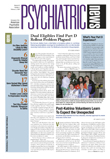Your patient reports he feels discouraged by his failure to find a job. He watches television or goes out drinking in the evening and rarely falls asleep before 3 a.m. You determine he has not only depression, but also inadequate sleep hygiene and a delayed sleep phase disorder.
This patient should receive all three diagnoses, says Michael Sateia, M.D., a professor of psychiatry and chief of sleep medicine at Dartmouth Medical School.
As this case suggests, multiple factors often contribute to difficulty sleeping, noted Sateia, who was editor of the recently published second edition of the International Classification of Sleep Disorders Diagnostic and Coding Manual (ICSD-2), published in 2005 by the American Academy of Sleep Medicine. The new edition replaces ICSD-1, published in 1990 and revised in 1997.
Since sleep symptoms frequently accompany psychiatric illness, Sateia said, psychiatrists should find ICSD-2 helpful in making a comprehensive assessment.
“Psychiatrists traditionally have viewed insomnia as a symptom of depression, but insomnia often has a life of its own,” he said. It may persist, even after mood improves. It requires treatment beyond the standard treatment for depression, particularly hypnotic medication and/or cognitive-behavioral therapy.
“If not treated,” he added, “insomnia may boost the likelihood of the depression's recurrence.”
Many sleep diagnoses outside the insomnia category also are highly relevant to psychiatry, he pointed out. As many as 50 percent of people with chronic schizophrenia have obstructive sleep apnea. Circadian rhythm sleep disorders have a high association with mood disorders. Some antidepressant medications trigger or increase periodic leg movements in sleep.
ICSD-2 represents consensus opinion from more than 100 sleep specialists worldwide. Its descriptions and criteria for sleep disorders, Sateia asserted, “are as rooted in evidence as available knowledge allows.”
The 300-page manual covers more than 80 discrete disorders, organized in eight categories. Unlike DSM-IV-TR, ICSD-2 does not use an axial system; it focuses only on the diagnosis of sleep disorders.
“While ICSD-2 enables psychiatrists who specialize in the treatment of sleep disorders to make finer distinctions than is possible in DSM-IV-TR, DSM-IV-TR's sleep disorders section continues to be useful for the general psychiatrist,” according to Michael First, M.D., cochair and editor of DSM-IV-TR and a research psychiatrist with the New York State Psychiatric Institute in New York City.
“The diagnostic codes in DSM-IV-TR were recently updated so as to be compatible with new International Classification of Diseases (ICD-9-CM) codes introduced as a result of ICSD-2,” First said. The codes are posted at<www.aasmnet.org/PDF/CrosswalkCard.pdf>.
Some disorders are grouped according to a common complaint; these include insomnia, hypersomnia, parasomnia, and sleep-related movement disorder. Others, such as circadian rhythm sleep disorders, are classified by presumed etiology. Still others are classified according to the organ system from which they arise.
Separate sections deal with disorders that involve isolated symptoms, such as sleep talking, and longer and shorter than normal sleep duration. Appendices review sleep disorders associated with medical disorders, such as sleep-related epilepsy or headaches, along with psychiatric and behavioral disorders frequently encountered in the differential diagnosis of sleep disorders.
For each disorder, ICSD-2 includes alternative names and describes essential and associated features, demographics, predisposing and precipitating factors, and familial patterns. It reports onset, course, and complications, as well as pathology and pathophysiology, and includes polysomnographic and other objective findings, diagnostic criteria, and subtypes.
Each section also addresses unresolved issues, further directions, and differential diagnosis, concluding with a concise bibliography. Most pediatric presentations are incorporated into the text for individual sleep disorders; three presentations unique to childhood are listed separately.
The new code for behavioral insomnia of childhood—a disorder child psychiatrists might encounter—has sparked consternation among some pediatric sleep specialists. This ICSD-2 disorder combines two ICSD-1 disorders, sleep onset association disorder and limit-setting sleep disorder. Its coding was downgraded to a “V” or“ problem” code usually reserved for lifestyle issues.
“A V code means insurance companies are unlikely to reimburse for this diagnosis,” said Judith Owens, M.D., an associate professor of pediatrics at Brown Medical School. “That may serve as a barrier to care for families of some children with this disorder.”
It also creates a pocketbook issue for practitioners, said Owens, who estimates that about 30 percent of the children in her pediatric sleep clinic have behavioral insomnia.
This disorder typically presents in the first or second year of life and probably involves a dysfunction in the child's ability to consolidate and self-regulate sleep, Owens explained, making it similar to psychophysiological insomnia in adults. Treatment involves teaching parents strategies to modify the child's behavior and improve the home sleep environment.
While pediatric sleep practitioners are campaigning to repeal this coding decision, work already has begun on ICSD-3. John Winkelman, M.D., Ph.D., an assistant professor of psychiatry at Harvard Medical School, chairs a task force on this issue.
Copies of ICSD-2 may be purchased at<www.aasmnet.org>.▪
